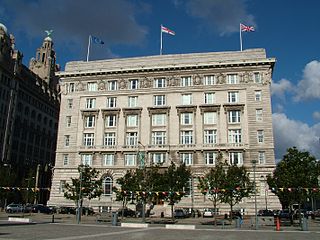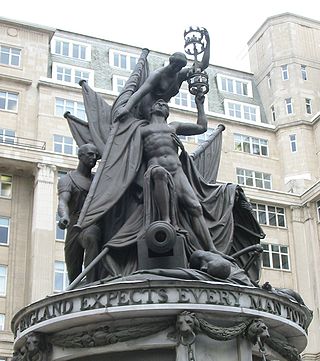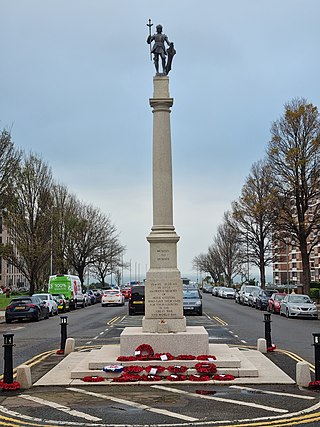
The Hall of Memory is a war memorial in Centenary Square, Birmingham, England, designed by S. N. Cooke and W. N. Twist. Erected 1922–25 by John Barnsley and Son, it commemorates the 12,320 Birmingham citizens who died in World War I.

The Tower Hill Memorial is a pair of Commonwealth War Graves Commission memorials in Trinity Square Gardens, on Tower Hill in London, England. The memorials, one for the First World War and one for the Second, commemorate civilian, merchant seafarers and fishermen who were killed as a result of enemy action and have no known grave. The first, the Mercantile Marine War Memorial, was designed by Sir Edwin Lutyens and unveiled in 1928; the second, the Merchant Seamen's Memorial, was designed by Sir Edward Maufe and unveiled in 1955. A third memorial, commemorating merchant seamen who were killed in the 1982 Falklands War, was added to the site in 2005.

The Cunard Building is a Grade II* listed building in Liverpool, England. It is located at the Pier Head and along with the neighbouring Royal Liver Building and Port of Liverpool Building is one of Liverpool's Three Graces, which line the city's waterfront. It is also part of Liverpool's former UNESCO designated World Heritage, the Maritime Mercantile City.

St George's Hall is a building on St George's Place, opposite Lime Street railway station in the centre of Liverpool, England. Opened in 1854, it is a Neoclassical building which contains concert halls and law courts, and is recorded in the National Heritage List for England as a designated Grade I listed building. On the east side of the hall, between it and the railway station, is St George's Plateau and on the west side are St John's Gardens. The hall is included in the William Brown Street conservation area.

The Philharmonic Dining Rooms is a public house at the corner of Hope Street and Hardman Street in Liverpool, Merseyside, England, and stands diagonally opposite the Liverpool Philharmonic Hall. It is commonly known as The Phil. It is recorded in the National Heritage List for England as a designated Grade I listed building.

The Royal Artillery Memorial is a First World War memorial located on Hyde Park Corner in London, England. Designed by Charles Sargeant Jagger, with architectural work by Lionel Pearson, and unveiled in 1925, the memorial commemorates the 49,076 soldiers from the Royal Artillery killed in the First World War. The static nature of the conflict, particularly on the Western Front, meant that artillery played a major role in the war, though physical reminders of the fighting were often avoided in the years after the war. The Royal Artillery War Commemoration Fund (RAWCF) was formed in 1918 to preside over the regiment's commemorations, aware of some dissatisfaction with memorials to previous wars. The RAWCF approached several eminent architects but its insistence on a visual representation of artillery meant that none was able to produce a satisfactory design. Thus they approached Jagger, himself an ex-soldier who had been wounded in the war. Jagger produced a design which was accepted in 1922, though he modified it several times before construction.

The Nelson Monument is a monument to Admiral Horatio Nelson, in Exchange Flags, Liverpool, England. It was designed by Matthew Cotes Wyatt and sculpted by Richard Westmacott. It stands to the north of the Town Hall and was unveiled in 1813.

George Herbert Tyson Smith (1883–1972) was an English sculptor born in Liverpool. He executed many works in the Liverpool and Merseyside area, in particular war memorials. He was the brother-in-law of fellow Liverpool sculptor Edward Carter Preston. Carter Preston designed the "Next of Kin Memorial Plaque" He was the uncle of the potter Julia Carter Preston.

Manchester Cenotaph is a war memorial in St Peter's Square, Manchester, England. Manchester was late in commissioning a First World War memorial compared with most British towns and cities; the city council did not convene a war memorial committee until 1922. The committee quickly achieved its target of raising £10,000 but finding a suitable location for the monument proved controversial. The preferred site in Albert Square would have required the removal and relocation of other statues and monuments, and was opposed by the city's artistic bodies. The next choice was Piccadilly Gardens, an area already identified for a possible art gallery and library; but in the interests of speedier delivery, the memorial committee settled on St Peter's Square. The area within the square had been had been purchased by the City Council in 1906, having been the site of the former St Peter's Church; whose sealed burial crypts remained with burials untouched and marked above ground by a memorial stone cross. Negotiations to remove these stalled so the construction of the cenotaph proceeded with the cross and burials in situ.

Rochdale Cenotaph is a First World War memorial on the Esplanade in Rochdale, Greater Manchester, in the north west of England. Designed by Sir Edwin Lutyens, it is one of seven memorials in England based on his Cenotaph in London and one of his more ambitious designs. The memorial was unveiled in 1922 and consists of a raised platform bearing Lutyens' characteristic Stone of Remembrance next to a 10-metre (33 ft) pylon topped by an effigy of a recumbent soldier. A set of painted stone flags surrounds the pylon.

Widnes War Memorial stands in Victoria Park, Widnes, Cheshire, England. It commemorates the serving men who lost their lives in the two world wars. The memorial consists of an obelisk in Portland stone on a plinth of York stone. It was unveiled in 1921, and more names were added in 1950. The monument is recorded in the National Heritage List for England as a designated Grade II listed building.

Macclesfield Cenotaph is a World War I memorial in Park Green, Macclesfield, Cheshire, England. It was unveiled in 1921, and consists of a stone pillar and pedestal and three bronze statues. One statue is that of a mourning female, and the others comprise Britannia laying a wreath over a soldier who had died from gassing, an unusual subject for a war memorial at the time. The memorial is recorded in the National Heritage List for England as a designated Grade II* listed building.

Birkenhead War Memorial, or Birkenhead Cenotaph, stands in Hamilton Square, Birkenhead, Merseyside, England, opposite the Town Hall. It consists of a cenotaph in Portland stone with carved figures and panels in Westmorland stone. The memorial was designed by Lionel Budden, and the sculptor was H. Tyson Smith. It was unveiled in 1925 by Lieutenant-General Sir Richard H. K. Butler. The memorial is recorded in the National Heritage List for England as a designated Grade II* listed building.

Southport War Memorial is in London Square, Lord Street, Southport, Merseyside, England. It consists of an obelisk flanked by two colonnades in the form of Greek temples. Outside the colonnades are memorial gardens, each containing a Pool of Remembrance and fountains. The memorial was designed by the local architects Grayson and Barnish, and the carving was executed by Herbert Tyson Smith. It was unveiled in 1923 by the Earl of Derby. Following the Second World War and subsequent conflicts further inscriptions and names have been added. The memorial is recorded in the National Heritage List for England as a designated Grade II* listed building.

The Guards Memorial, also known as the Guards Division War Memorial, is an outdoor war memorial located on the west side of Horse Guards Road, opposite Horse Guards Parade in London, United Kingdom. It commemorates the war dead from the Guards Division and related units during the First World War, and of the Household Division in the Second World War and other conflicts since 1918.

Norwich War Memorial is a First World War memorial in Norwich in Eastern England. It was designed by Sir Edwin Lutyens, the last of his eight cenotaphs to be erected in England. Prior to Lutyens' involvement, several abandoned proposals had been made for commemorating Norwich's war dead, and by 1926 the newly elected lord mayor was determined to see the construction of a memorial before he left office. He established an appeal to raise funds for local hospitals in memory of the dead as well as a physical monument. He commissioned Lutyens, who designed an empty tomb (cenotaph) atop a low screen wall from which protrudes a Stone of Remembrance. Bronze flambeaux at either end can burn gas to emit a flame. Lutyens also designed a roll of honour, on which the names of the city's dead are listed, which was installed in Norwich Castle in 1931.

Hove War Memorial is a First World War memorial designed by Sir Edwin Lutyens and located on Grand Avenue in Hove, part of the city of Brighton and Hove, on the south coast of England. Hove was the site of one of the earliest recruiting events at the beginning of the war and later of several military hospitals. Over 600 men from the town were killed during the war, a quarter of them from the local regiment alone. A war memorial committee was established in 1919 and Lutyens was engaged as architect. A design was agreed in 1920 after two unsuccessful proposals; Lutyens chose the site from several options.

The Royal Artillery Boer War Memorial is located on the south side of The Mall in Central London, close to the junction with Horse Guards Road at the northeast corner of St James's Park. Unveiled in 1910, it marks the deaths of the 1,083 soldiers of the Royal Artillery who died in the Second Boer War from 1899 to 1902 It has been a listed building since 1970.

George's Dock Building is a Grade II listed building in Liverpool, England. It is located at the Pier Head on the city's waterfront. It is part of Liverpool's former UNESCO designated World Heritage Maritime Mercantile City. It was built in the 1930s in the Art Deco style, to the designs of architect Herbert Rowse. Occupants of the office space include, Merseytravel, The Liverpool City Region Combined Authority, Mersey Tunnels staff and The Mersey Tunnels Police. It also houses ventilation machinery for the Queensway Tunnel and the Mersey Tunnels Tour Offices.

The City of Portsmouth War Memorial, also referred to as the Guildhall Square War Memorial, is a First World War memorial in Guildhall Square in the centre of Portsmouth, Hampshire, on the south coast of England. Portsmouth was and remains a port and home to a major naval dockyard. The dockyard and the armed forces provided much of the employment in the area in the early 20th century. As such, the town suffered significant losses in the First World War. Planning for a war memorial began shortly after the end of the conflict and a committee was established for the purpose. It selected a site adjacent to a railway embankment close to the Town Hall and chose the architects James Gibson and Walter Gordon, with sculptural elements by Charles Sargeant Jagger, from an open competition.






















